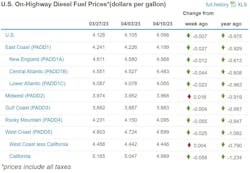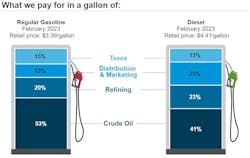Diesel down slightly as U.S. average falls for 10th week in a row
Diesel fuel prices again failed the week of April 10 to follow the path of gasoline, which has surged recently. Instead, the U.S. average per-gallon price for trucking’s main fuel fell, though by less than a penny, according to brand-new U.S. Energy Information Administration (EIA) data.
While gas nationwide shot up almost a dime per gallon the week of April 10 (and rose in all but one EIA region) following a 7.6-cent surge last week, diesel kept going the opposite direction, falling by seven-tenths of a penny to $4.098 per gallon after a 2.3-cent decrease the week of April 3, according to the latest EIA data.
See also: 2023 alternative-fuel engine outlook
Diesel is down now for the 10th week in a row, while the U.S. gasoline average is up for the second straight week. Gasoline typically rises in the spring heading into the busy summer travel season, but other factors also may be coming into play, analysts said.
Motor club AAA is tracking the same trends. While AAA has been seeing incremental price increases for gas, its U.S. average for diesel also fell on April 10 (though also by less than a penny) to $4.195 per gallon.
According to EIA, the prices of both diesel and gasoline are nevertheless well below their levels of a year ago—diesel now by a bit less than $1 per gallon. Diesel is 97.5 cents below last year at this time, while gas is 49.5 cents lower than a year ago.
See also: Veteran drivers teach how to reach 10 MPG at MATS 2023
Could the tide turn soon for diesel, too?
After they spent a few weeks falling, per-barrel oil prices—a traditional barometer of future fuel prices—are headed back up. Both West Texas Intermediate crude and Brent crude floated at or above $80 per barrel on the morning of April 11, an increase of a few dollars per barrel compared to recent weeks.
But when it comes to oil and the fuels refined from it, there are other contradictory indicators. The economic slowdown is accelerating, which is translating into lower global prices for distillates such as gas oil and diesel. More refineries also are coming online and exports from Russia are being routed away from the U.S. and replaced by fuel from the Middle East, according to an April 5 report from Reuters.
See also: The emissions race: Does trucking's future still have ICE in its veins?
U.S. crude inventories are down 3.7 million barrels from last week, according to FleetOwner’s sister publication, Oil & Gas Journal. However, this leaves about 470 million barrels on hand and is 4% above the five-year average for this time of year, according to EIA's data.
A GasBuddy analyst laid the price increases for gasoline at the feet of OPEC production cuts. As for diesel, the analyst, GasBuddy's head of petroleum Patrick De Haan, indicated that retail prices for U.S. trucking's main fuel will continue to ease.
"We should see the average price for diesel continuing to inch down. Of course, that remains a wild card if OPEC further cuts oil production or if there are any refinery hiccups, that could change," De Haan said. "But diesel prices [are] continuing to moderate."
About the Author
Scott Achelpohl
Managing Editor
Scott Achelpohl is a former FleetOwner managing editor who wrote for the publication from 2021 to 2023. Since 2023, he has served as managing editor of Endeavor Business Media's Smart Industry, a FleetOwner affiliate.



